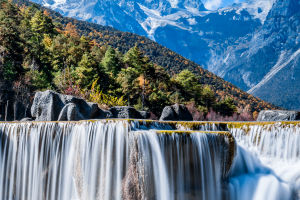Dunes are fascinating natural features that can be found in various locations around the world, including coastal areas, river valleys, and arid regions. They are typically formed by the action of wind on unconsolidated sand and are often associated with large deserts such as the Sahara and the Taklamakan.
The formation of dunes is dependent on two main factors: a dry climate, and strong winds that can move loose material. In regions with a lack of rainfall, sand and other materials are unable to solidify and become compacted, making them vulnerable to being picked up and carried by the wind. Once the wind begins to move sand particles, they can accumulate and form dunes.
In desert regions, there is typically a dominant wind direction that causes the sand to move in a particular direction. The sand on the windward side of a dune is pushed forward by the wind, while the sand on the leeward side slides down the slope and accumulates at the base of the dune. As a result, dunes are constantly shifting and moving in the direction of the prevailing winds.
The shape and size of dunes can vary depending on several factors, including the type and size of the sand particles, the strength and direction of the winds, and the presence of other geological features. Some common types of dunes include crescent-shaped dunes, longitudinal dunes, pyramid-shaped dunes, and honeycomb-shaped dunes.
Crescent-shaped dunes are among the most common types of dunes and are characterized by their distinctive crescent shape. These dunes have two sharp angles on either side that extend downwind and are typically formed by the interaction of high winds and low air pressure on the windward side, which creates a vortex that piles up sand on either side of the dune.
The formation of dunes is not only influenced by climate and wind, but also by human activity. Deforestation, soil erosion, and the destruction of grasslands can all contribute to the formation of dunes in regions where they might not otherwise occur.
Despite their beauty and intrigue, dunes can also have negative impacts on their surrounding ecosystems. In arid regions, dunes can cause soil erosion, making it more difficult for plants and other organisms to thrive. In coastal areas, dunes can help protect against erosion and storm surges, but can also impede the flow of water and nutrients to other ecosystems.
Dunes are especially prevalent in the country's deserts, where they form vast seas of sand with undulating waves and vastness. Different types of dunes can be found in these regions, including mobile, fixed, and semi-fixed dunes.
Mobile dunes are typically not covered in vegetation and experience high levels of wind and sand activity. Semi-fixed dunes, on the other hand, have some vegetation cover and experience lower levels of wind and sand activity.
Fixed dunes are fully covered in vegetation and are relatively stable, though they can still be subject to erosion and other forms of environmental change.
Dunes are a unique and intriguing feature of the natural world that is shaped by a variety of environmental factors, including climate, wind, and human activity.
While they can have both positive and negative impacts on the ecosystems around them, they remain a captivating and awe-inspiring sight for many people around the world.


